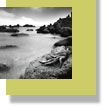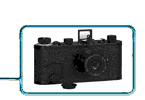![]()
|
Martha
Casanave: Costal Pinholes
|
|
I had already done a lot of pinhole photography. One project involved narrative style scenarios and nudes in my natural-light studio. For that I adapted my 4x5 camera with a crude aluminum foil pinhole in a lensboard. The other project was a study of Leningrad in Winter—gee, I guess that was outdoors— and for that I fitted my Nikon with a pinhole made in a body cap.
This time, however, I took with me a wooden box pinhole camera I’d had for at least eight years and had never used except for demonstrations in the classroom. Something must have been simmering in my unconscious, because I woke up the morning of our appointment with an image of a starfish in my mind. I realized that image, and that one started a flow of more. I soon realized, however, that the “natural scene” wasn’t enough for me. I had to get my hand in the pictures. So I began photographing what I jokingly refer to either as “the unnatural scene,” or “the supernatural scene.”
I feel pretty ridiculous as I teeter on the rocks, slipping, sliding, and wildly waving my arms, backpack swaying and tilting me off balance. I carry a brown paper sack full of “props” in one hand and a shower curtain (to sit on in wet sand) slung over my shoulder. I don’t carry a tripod, as any self-respecting landscape photographer would do. I decided that these pictures would all be from a crab’s-eye view, with the camera either on a rock or directly on the sand. I use sandbags, made on the spot, to stabilize the camera. I use a level to get the horizon straight.
And what a mess! Sand in everything! Dirt and scratches all over the negatives! Every negative seems to have its share of anomalies. If I complain to colleagues, I get this advice “Hey, Photoshop will take care of all that!” Being an indoor person at heart does not mean I enjoy sitting at a computer. So never mind. Instead, I take as my role model Julia Margaret Cameron, early girl-photographer, who was excoriated in the British Journal of Photography in 1865 for her “slovenliness.” So she wasn’t compulsive about technical perfection. It was hard coating those big glass plates without getting dirt on them! And all that silver nitrate she dripped in the dining room! But she had fun, and she worked with passion. And the power that passion imbued in her imperfect prints kept them alive through the ages. The 19th century is, for me, the most fascinating period of history; one reason is because, along with other technological developments, it witnessed the invention and rapid growth of photography from the daguerreotype to roll film. For me photography is like magic. Scientific explanations don’t help a bit — they only make it seem more magical. And the pinhole principle, which actually far pre-dates the ability to make an image permanent, is even more magical for me. Its allure is its very primal simplicity — a box with a tiny hole making an image. No lens, no shutter, no viewfinder. An optical phenomenon, unadorned by mechanics or, God forbid, electronics. One of the properties of this phenomenon is its nearly infinite depth of field (from the camera’s focal-length distance to infinity). I am using this ability to render both near and far with the same sharpness in many of the coastal images.
And, speaking of far — lately, a mysterious figure in black 19th century clothing has begun appearing in the distance in some of my images. Who is this person? Might he be leading me somewhere? He could very well personify the principle that I subscribe to, that doing creative work will take you where you’ve never been, where you need to go, and where the unknown will become known.
Technical Information: Camera – a three-inch wooden box from the Santa Barbara Lenless Camera Co. Film – 4x5" Tri-X. Exposures vary from 4 - 16 seconds. Tray developed in HC-110, Dilution B, for 4.5 minutes. Exhibition prints are 16x20" on Ilford Multigrade FB Warmtone (semi-matte), heavily toned with selenium.
MARTHA CASANAVE first moved to the Monterey Peninsula in 1966. After a year of working as an assistant photographer in New York, she returned to the Peninsula with the aim of earning her living as a photographer. She became well-known on the Peninsula for her fine-art environmental portraits, making non-traditional black and white portraiture her signature style.
Casanave has made eleven trips to the Soviet Union/Russia, the last ten from 1984 to 1995. Using her knowledge of the Russian language and culture, she has led groups of photographers on professional tours, linking them with their counterparts in Russia. She established a working relationship with the Russian Union of Art Photographers, helping them organize, in 1991, the first all-woman international photography exhibition and symposium in Russia — an event that now occurs regularly. Casanave’s portrait project with immigrants from the Soviet Union won her the Imogen Cunningham Photography Award in 1979. Her Russian photography work brought her a nomination for the Koret Israel Prize, which she won in 1989. Casanave has had strong support over the years from the Polaroid Corporation, and has received several Print Collection grants.
For twenty-two years Casanave has taught master classes on portraiture, the human figure and other topics at workshop programs around the country and abroad. She also holds private workshops in Monterey. She teaches regularly at Cabrillo College in Santa Cruz, at Monterey Peninsula College, and for the University of California at Santa Cruz Extension.
Casanave’s first book, Past Lives: Photographs by Martha Casanave, was published by Godine in 1991. Her pinhole work has appeared in several issues of the Pinhole Journal, and was featured in a 1991 issue of View Camera. A selection of her pinhole work was included in Reframings: New American Feminist Photographies, edited by Diane Neumaier (1995). She was included in the “Women and Creativity” issue of Camera Arts, and interviewed in the Fall 1998 issue of Photographers’ Forum, “Martha Casanave The Receptive Eye.” She is currently working on her second book.
Martha Casanave’s photographs have been widely exhibited and are included in such collections as the Boston Museum of Fine Arts, the Stanford Museum, the Art Institute of Chicago and the Bibliotheque Nationale.







